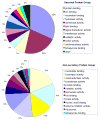Proteomic analysis of Schistosoma mansoni proteins released during in vitro miracidium-to-sporocyst transformation
- PMID: 19095013
- PMCID: PMC2665799
- DOI: 10.1016/j.molbiopara.2008.11.005
Proteomic analysis of Schistosoma mansoni proteins released during in vitro miracidium-to-sporocyst transformation
Abstract
Free-living miracidia of Schistosoma mansoni, upon penetration of the their snail intermediate host, undergo dramatic morphological and physiological changes as they transform to the parasitic sporocyst stage. During this transformation process, developing larvae release a diverse array of proteins, herein referred to as larval transformation proteins (LTPs), some of which are postulated to serve a parasite protective function. In the present study, nanoLC-tandem MS analysis was performed on all proteins represented in entire 1-dimensional SDS-PAGE-separated samples in order to gain a more comprehensive picture of the protein constituents associated with miracidium-to-sporocyst transformation and thus, their potential role in influencing establishment of intramolluscan infections. Of 127 proteins with sufficient peptide/sequence information, specific identifications were made for 99, while 28 represented unknown or hypothetical proteins. Nineteen percent of identified proteins possessed signal peptides constituting a cohort of classical secretory proteins, while 22% were identified as putative nonclassically secreted leaderless proteins based on SecretomeP analysis. Proteins comprising these groups consisted mainly of proteases/protease inhibitors, small HSPs, redox/antioxidant enzymes, ion-binding proteins including those with anti-oxidant Fe-binding activities (ferritins, heme-binding protein), and venom allergen-like (VAL) proteins. A polyclonal antibody generated against whole LTPs recognized proteins primarily associated with the cilia, ciliated epidermal plates and intercellular ridges of miracidia and the tegument of fully transformed sporocysts, identifying these structures as sources of a subset of LTPs. Thus lysis of plates and/or leakage during formation of the sporocyst syncytium likely represent significant contributors to the overall LTP makeup, especially identified nonsecretory proteins. However, as plate release/degradation and tegument formation are part of the normal developmental process, all LTPs regardless of tissue origin, would be expected at the parasite-host interface upon infection. This study significantly expands the repertoire of LTPs associated with larval transformation and identifies several, e.g., those involved in stress responses, proteolysis/inhibition, antioxidant and detoxication, and immune modulation, that may play a parasite protective role during this crucial period of transition.
Figures
Similar articles
-
Protein kinase C signalling during miracidium to mother sporocyst development in the helminth parasite, Schistosoma mansoni.Int J Parasitol. 2009 Sep;39(11):1223-33. doi: 10.1016/j.ijpara.2009.04.002. Epub 2009 Apr 24. Int J Parasitol. 2009. PMID: 19394337
-
Time series analysis of tegument ultrastructure of in vitro transformed miracidium to mother sporocyst of the human parasite Schistosoma mansoni.Acta Trop. 2023 Apr;240:106840. doi: 10.1016/j.actatropica.2023.106840. Epub 2023 Jan 18. Acta Trop. 2023. PMID: 36681315
-
Schistosoma mansoni: DNA microarray gene expression profiling during the miracidium-to-mother sporocyst transformation.Mol Biochem Parasitol. 2006 May;147(1):39-47. doi: 10.1016/j.molbiopara.2006.01.006. Epub 2006 Feb 2. Mol Biochem Parasitol. 2006. PMID: 16483678
-
Schistosoma mansoni: the ultrastructure of larval morphogenesis in Biomphalaria glabrata and of associated host-parasite interactions.Jpn J Med Sci Biol. 1996 Aug;49(4):129-49. doi: 10.7883/yoken1952.49.129. Jpn J Med Sci Biol. 1996. PMID: 9086392 Review.
-
Receptors for growth and development of Schistosoma mansoni.J Helminthol. 2025 Feb 14;99:e29. doi: 10.1017/S0022149X24001020. J Helminthol. 2025. PMID: 39949117 Review.
Cited by
-
Comparative study of excretory-secretory proteins released by Schistosoma mansoni-resistant, susceptible and naïve Biomphalaria glabrata.Parasit Vectors. 2019 Sep 14;12(1):452. doi: 10.1186/s13071-019-3708-0. Parasit Vectors. 2019. PMID: 31521183 Free PMC article.
-
Role for a somatically diversified lectin in resistance of an invertebrate to parasite infection.Proc Natl Acad Sci U S A. 2010 Dec 7;107(49):21087-92. doi: 10.1073/pnas.1011242107. Epub 2010 Nov 17. Proc Natl Acad Sci U S A. 2010. PMID: 21084634 Free PMC article.
-
Molluscan cells in culture: primary cell cultures and cell lines.Can J Zool. 2013 Jun 1;91(6):10.1139/cjz-2012-0258. doi: 10.1139/cjz-2012-0258. Can J Zool. 2013. PMID: 24198436 Free PMC article.
-
Time series analysis of the transcriptional responses of Biomphalaria glabrata throughout the course of intramolluscan development of Schistosoma mansoni and Echinostoma paraensei.Int J Parasitol. 2010 Jun;40(7):819-31. doi: 10.1016/j.ijpara.2009.12.005. Epub 2010 Jan 18. Int J Parasitol. 2010. PMID: 20083115 Free PMC article.
-
A large repertoire of parasite epitopes matched by a large repertoire of host immune receptors in an invertebrate host/parasite model.PLoS Negl Trop Dis. 2010 Sep 7;4(9):e813. doi: 10.1371/journal.pntd.0000813. PLoS Negl Trop Dis. 2010. PMID: 20838648 Free PMC article.
References
-
- Basch PF, DiConza JJ. The miracidium-sporocyst transition in Schistosoma mansoni: surface changes in vitro with ultrastructural correlation. J Parasitol. 1974;60:935–41. - PubMed
-
- Pan CT. Schistosoma mansoni: the ultrastructure of larval morphogenesis in Biomphalaria glabrata and of associated hot-parasite interactions. Jpn J Med Sci Biol. 1996;49:129–49. - PubMed
-
- Lodes MJ, Yoshino TP. Characterization of excretory-secretory proteins synthesized in vitro by Schistosoma mansoni primary sporocysts. J Parasitol. 1989;75:853–62. - PubMed
-
- DeGaffe G, Loker ES. Susceptibility of Biomphalaria glabrata to infection with Echinostoma parensei: correlation with the effect of parasite secretory-excretory products on host hemocyte spreading. J Invertebr Pathol. 1998;71:64–72. - PubMed
-
- Bayne CJ, Yoshino TP. Determinants of compatibility in mollusk-trematode parasitism. Amer Zool. 1989;29:399–407.
Publication types
MeSH terms
Substances
Grants and funding
LinkOut - more resources
Full Text Sources
Research Materials






